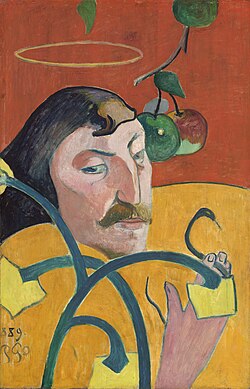| Self-Portrait | |
|---|---|
 | |
| Artist | Paul Gauguin |
| Year | 1889 |
| Type | Oil painting on wood |
| Dimensions | 79 cm × 51 cm (31.2 in × 20.2 in) |
| Location | National Gallery of Art, Washington, D.C. |
Self-Portrait with Halo and Snake, also known as Self-Portrait, is an 1889 oil-on-wood painting by French artist Paul Gauguin, which represents his late Brittany period in the fishing village of Le Pouldu in northwestern France. No longer comfortable with Pont-Aven, Gauguin moved on to Le Pouldu with his friend and student Meijer de Haan and a small group of artists. He stayed for several months in the autumn of 1889 and the summer of 1890, where the group spent their time decorating the interior of Marie Henry's inn with every major type of art work. Gauguin painted his Self-Portrait in the dining room with its companion piece, Portrait of Jacob Meyer de Haan (1889).
The painting shows Gauguin against a red background with a halo above his head and apples hanging beside him as he holds a snake in his hand while plants or flowers appear in the foreground. The religious symbolism and the stylistic influence of Japanese wood-block prints and cloisonnism are apparent. The portrait was completed several years before Gauguin visited Tahiti and is one of more than 40 self-portraits he completed during his lifetime.[note 1] The work reached the art market in 1919 when Marie Henry sold it at the Galerie Barbazanges in Paris as part of her collected works from the Le Pouldu period. American banker Chester Dale acquired the painting in 1928, gifting it upon his death in 1962 to the National Gallery of Art in Washington, D.C.
Cite error: There are <ref group=note> tags on this page, but the references will not show without a {{reflist|group=note}} template (see the help page).